| کد مقاله | کد نشریه | سال انتشار | مقاله انگلیسی | نسخه تمام متن |
|---|---|---|---|---|
| 9522438 | 1634975 | 2005 | 16 صفحه PDF | دانلود رایگان |
عنوان انگلیسی مقاله ISI
The effect of sloped isotherms on melt migration in the shallow mantle: a physical and numerical model based on observations in the Oman ophiolite
دانلود مقاله + سفارش ترجمه
دانلود مقاله ISI انگلیسی
رایگان برای ایرانیان
کلمات کلیدی
موضوعات مرتبط
مهندسی و علوم پایه
علوم زمین و سیارات
علوم زمین و سیاره ای (عمومی)
پیش نمایش صفحه اول مقاله

چکیده انگلیسی
Field observations in the Oman ophiolite and petrological data are used to constrain a model of melt segregation at the top of the mantle beneath an oceanic spreading centre. Foliations and lineations in outcrops of mantle-derived peridotites oriented at high angle relative to the crust-mantle boundary have been interpreted as the footprint of a former axial asthenospheric convective upwelling several kilometers in cross-section that reached Moho levels. Basaltic melts migrating through this upwelling reacted with their host harzburgites and suffered fractional crystallization. The mantle-crust transition zone at the top of the upwelling is characterized by an very thick (about 400 m) dunite layer whose detailed structure and composition point to the development by compaction of a former “mantle mush”. The more important structures (in terms of volume of crystallization products) found in the underlying harzburgites are dunitic-troctolitic horizons a few meters thick and of lateral extent reaching 1 km and more. They crystallized at high temperature (>1190 °C) from melts similar to mid-ocean ridge basalts (MORB). These are called “sills” because they are sub-parallel to the crust-mantle boundary, but they can present a moderate dip (15° to 20° at most) relative to this paleo-horizontal surface. These observations have motivated the modelling of melt segregation by compaction within the crystallization domain inside the top convective boundary layer of the mantle upwelling. Two original inputs to the modelling are considered here: (i) the slope of the iso-curves of melt concentration due to the progressive cooling of the mantle in the boundary layer away from the axis of the rising convective flow; (ii) the reduction in permeability caused by the crystallization of the inter-granular melt. Modelling shows that a unique condition is required to generate the troctolite sills and the thick dunite layer nested at the top of the Maqsad diapir: namely a dramatic drop of the interstitial melt concentration at the top of the mantle. Besides, the model developed here allows to scale the time, volume and velocity of the melt segregation.
ناشر
Database: Elsevier - ScienceDirect (ساینس دایرکت)
Journal: Earth and Planetary Science Letters - Volume 229, Issues 3â4, 15 January 2005, Pages 231-246
Journal: Earth and Planetary Science Letters - Volume 229, Issues 3â4, 15 January 2005, Pages 231-246
نویسندگان
Michel Rabinowicz, Georges Ceuleneer,